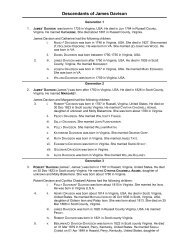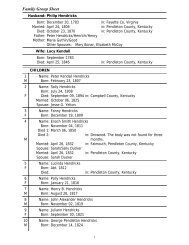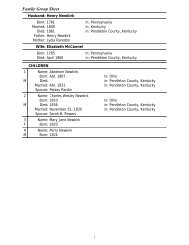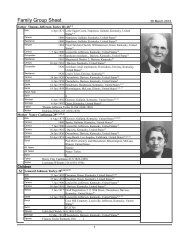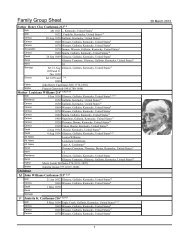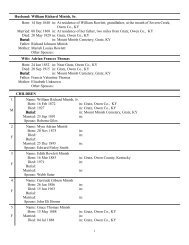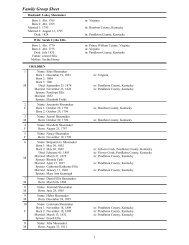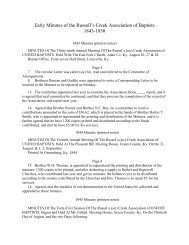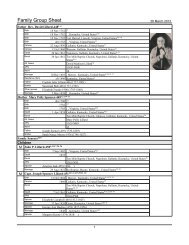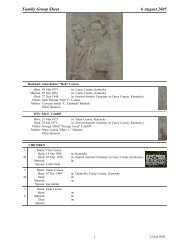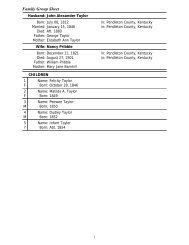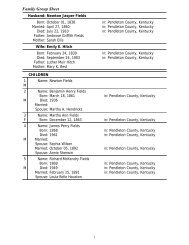TOWNS OF EAST KENTUCKY. - KyKinfolk
TOWNS OF EAST KENTUCKY. - KyKinfolk
TOWNS OF EAST KENTUCKY. - KyKinfolk
Create successful ePaper yourself
Turn your PDF publications into a flip-book with our unique Google optimized e-Paper software.
<strong>TOWNS</strong> <strong>OF</strong> <strong>EAST</strong> <strong>KENTUCKY</strong>.<br />
--.--<br />
CATLETTSBURG.<br />
GREAT FIRES.<br />
ON the 22d of July, 1877, at t,velve o'clock,<br />
noon, a fire broke out in Peter Paul Schauer's<br />
bakery, on South Front Street, and destroyed all<br />
of the business part of the town. The fire only<br />
raged three hours, but its work was complete.<br />
Every business house (including every hotel), save<br />
Coon Wait's grocery, was destroyed. 'In six months<br />
most of the "burnt district" ,vas built up ·with<br />
substantial brick edifices. No one received the<br />
slightest injury to' limb in contending with this<br />
great conflagration.<br />
SECOND GREAT FIRE.<br />
AT one o'clock A. M., during the latter part of<br />
the month of August, 1884, a fire started in the<br />
great drug-house of Patton Bros., and spread on<br />
one side to Prichard & Wellman's ,vholesale<br />
grocery, D. H. Carpenter's ,vholesale dry-goods<br />
house, and a small brick adjoining, and on the<br />
other side to N. P. A.ndrews's dry-goods store, all<br />
of ,vhich ,vere consumed, with most of their contents.<br />
James McKenzie, a young tinner, and David<br />
Kinner, a young business luan of ",Villiamsburg,
272 THE BIG SANDY VALLEY.<br />
craft to the shore below the mouth of the Sandy<br />
River, there to remain until the day arrived to dispose<br />
of her by public outcry. But the swirl produced<br />
by the mad waves ingulfed the stout craft,<br />
and tore her cabin, keel, and hull into thousands of<br />
fragments, with as little ceremony as if she had<br />
been a partridge-trap. The destruction of this boat<br />
by the rushing waters was the cause of a vexatious<br />
law-suit, brought by the owner of the boat against<br />
the sheriff for failure to save the craft. After a<br />
controversy running through seven or eight years,<br />
the sheriff gained the suit.<br />
OHIO RIVER FLOOD <strong>OF</strong> 1883.<br />
THE February flood of 1883 was many feet<br />
higher than the river had attained since December,<br />
1847, and ,vas even higher than in that great overflow.<br />
The indications for several days previous to<br />
any thing like a very high river, as ·well as telegraphic<br />
reports from the head-waters above, gave<br />
ample warning to the citizens of Catlettsburg to<br />
set their houses in order, to prepare for a great inundation.<br />
When the waters of the great flood appeared on<br />
the floors of the houses on the lo,ver streets of the<br />
town, the occupants, \vhile not \velcoming the ·watery<br />
messenger as a willing guest, submitted to its silent<br />
entrance ·with a grace and resignation most commendable,<br />
knowing that no protest ,vould or could<br />
prevent the god of ,vaters from making pantry,
C.ATLETTSB URG. 273<br />
kitchen, and parlor the haunts of his revels for at<br />
least several days; and so the inhabitants made this<br />
overflow a time of social enjoyment. Boating, sailing,<br />
skiff-riding, and social calling by the gay<br />
belles and beaus were indulged in to an extent<br />
almost unparalleled in the history of the town.<br />
The waters came into most of the houses not situated<br />
on or near the bluffs. They endured the siege<br />
good-humoredly. After a week's besiegement,<br />
many who had been driven to the second stories of<br />
their houses, and those who abode in one-story<br />
houses to other more fa \Tored retreats, were once<br />
more enthroned in their homes, ,vhich were made<br />
nicer by the thorough ,vash-out given them by the<br />
flood; and in three months it would have been difficult<br />
for one not a resident of the place to have<br />
known by ocular proof that any thing like a great<br />
overflo,v. had visited the place.<br />
Of course the people ,vere greatly inconvenienced,<br />
and business was suspended for the time;<br />
but no great loss fell on anyone, and had not the<br />
greater flood of the next year visited the place, the<br />
people ,vould have looked back to this one as, in<br />
many aspects, a forced gala-day.<br />
DELUGE <strong>OF</strong> FEBRUARY, 1884.<br />
THE immense snow on the ground in the early<br />
part of February made the people restive; but<br />
when the heavens were darkened with clouds ominous<br />
of rain, followed by t\venty-four hours of one
274 THE BIG SANDY VALLEY.<br />
continual down-pour, the people felt their doom<br />
had come. They rallied as best they could, and<br />
set their houses, stores, factories, shops, and barns<br />
in order, to meet what was apparent to them, the<br />
coming of the greatest flood which had ever invaded<br />
their borders. By the tenth of the month<br />
the muddy waters had invaded all the houses in<br />
the lower portions of the town, and at the expiration<br />
of three more days, most of the houses in to,vn<br />
were under water, some from one to four feet in the<br />
second story. Many inmates of two-story buildings<br />
had to abandon their homes, and seek shelter, which<br />
in many instances was most hospitably offered by<br />
the fortunate dwellers on the highlands of the<br />
town. Others took refuge on boats, both steam<br />
and flat, tied to trees growing in the to,vn. This<br />
great deluge kept the people imprisoned for seven<br />
days. It was so far-reaching in its destruction<br />
that, for several days, many people suffered for the<br />
want of fire and food. But the famine was at<br />
length broken, as supplies came in from many<br />
quarters.<br />
The people of Ashland, always noted for humane<br />
acts, early came to the rescue with provisions and<br />
coal. Colonel Jay H. Northup, passing up to his<br />
home at Louisa when the flood was beginning to<br />
assume alarming proportions, gave the alarm there,<br />
and no people could have responded with greater<br />
alacrity and with fuller hands of benevolence than<br />
did the noble people of Louisa. Catlettsburg 'v ill
CATLETTSB URG. 275<br />
never forget their noble generosity. To cap the<br />
Louisa climax of fraternal charity, the noble order<br />
of Odd Fello,vs in that place, although a small<br />
band, set to work among themselves and supplemented<br />
the public charity of the people by sending<br />
to their water-beleaguered brethren at the Gate a<br />
supply of roasted ham, home-made light bread,<br />
baked turkeys, and chickens, besides many delicacies,<br />
altogether making a menu that an epicure<br />
would envy. All of these creature comforts were<br />
speedil y transported to the people of Catlettsburg<br />
by volunteers from Louisa. Catlettsburg will never<br />
forget Colonel Northup nor the noble people at the<br />
Forks. Catlettsburg Odd Fellows will remember<br />
their noble brethren up there ,vith heartfelt fraternal<br />
love.<br />
Secretary Lincoln, at the request of Congressman<br />
Culbertson, sent a draft for $1,000. The<br />
State of Kentucky did handsomely, and that prince<br />
among gentlemen, Secretary of State Colonel<br />
McKenzie, came up to the Gate to see that the<br />
stores were properly distributed, and to encourage<br />
the distressed people. Many of our o\vn citizens<br />
deserve great praise for their noble deeds of love<br />
and charity. Colonel Laban T. Moore gave food<br />
and shelter to all destitute of the same as long as<br />
any space was available in his large mansion, helping<br />
the extreme pOQr as well as the rich. James<br />
Wellman, R. C. Burns, 'V. N. Lanham, Captain<br />
Dye, John C. Eastham, Rev. Hanford, John Henry
276 THE BIG SANDY VALLEY.<br />
Ford, E. T. Spencer, D. W. Eba, Captain Hopkins,<br />
Thomas Bro,vn, George N. Brown, C. S. Ulen, Mrs.<br />
Rebecca Patton, Mrs. Richardson, and Rev. Mr.<br />
Meek, editor of the Central Methodist, gave over six<br />
hundred meals away, and never received one cent<br />
in return, not even in the provisions purchased<br />
·with Government funds. But he and all who<br />
opened their houses to the flood sufferers have a<br />
better reward.<br />
Those whom we have named lived above the<br />
,vater-line. A. thousand kind deeds were done by<br />
Dthers whose premises were inundated, yet having<br />
a fello,v-feeling in common ,vith humanity were<br />
busy in attending to the wants of the aged, the<br />
sick, and helpless poor.<br />
When the flood disappeaTed from the lower<br />
floors and lawns, one could have a faint glimmer of<br />
the appearance of things after the subsidence of<br />
the great Deluge of Noah :-plastering falling from<br />
walls and ceiling; paper entirely ruined; windo,vs<br />
broken, and doors so s,vollen out of size that<br />
they ,vould not close; floors covered ,vith yello,v<br />
sediment several inches thick. Inside all ,vas dark<br />
and gloomy. Without all ,vas chaos. Logs, old<br />
gates, fence-rails, broken jars, a dilapidated bench,<br />
a dead cat, an old day-book, a broken sieve, a rolling-pin,<br />
paper bag full of spoiled crackers, a dead<br />
chicken-the ,vhole medley, and much more, covered<br />
with mud three inches thick-greeted you.<br />
But look farther on, and all of the smaller outbuild-
CATLETTSBURG. 277<br />
ings are gone. The barn is turned upside-down,<br />
and is a total wreck inside. The fences are all<br />
washed away. The alley in the rear of your premises<br />
is choked up with logs and drift-wood, and<br />
you can't get any thing hauled from that quarter.<br />
You look further on, and you see all of your<br />
neighbors in the same wretched condition as yourself.<br />
You take a census, and it sho,vs that forty<br />
dwellings, shops, and stores have been ,vashed<br />
from their foundations by the great flood. Only<br />
two or three of them could be returned; six or<br />
seven of them were never more seen nor heard<br />
from. The remainder ,vere sold for trifles, to parties<br />
near by where they had lodged, or were wrecked and<br />
used for something, or were abandoned to anyone<br />
who chose to use them. The store-buildings, great<br />
and small, presented a ,voe-begone aspect-plateglass<br />
windows broken in; goods ,vet and dripping;<br />
owners cross and crabbed; no doors to shut the<br />
cold out, they were so badly swollen; every thing<br />
confusion. Housewives were tired down with<br />
anxiety, watching, and hard work, and children<br />
were cross and fretful.<br />
Plenty of laborers offered their services to work,<br />
but generally at high prices. One week ,vas spent<br />
in washing out houses} putting down carpets, and<br />
placi.ng furniture; the next was spent in repairing<br />
,valls and ceilings, and fitting in windows and<br />
doors. In a week more canle paper-hangers and<br />
decorators, followed by the painter. During all
280 THE BIG SANDY VALLEY.<br />
seat of the Catlettsburg graded school. At present<br />
four professors do the work. The tuition is free,<br />
the people of the town supplementing the State<br />
tax, to keep the school in operation ten nlonths in<br />
the year. The school-buildings in both of the<br />
principal suburbR are first-class frame buildings.<br />
The colored children have the advantage of a five<br />
months' school.<br />
The East Kentucky Normal School has become<br />
one of the most noted and popular institutions of<br />
learning in the State. Its beautiful grounds, laid<br />
off into ,valks, parks, flower-plats, as well as its<br />
fine buildings, make it the pride of Catlettsburgers,<br />
and of Big Sandians as ,veIl.<br />
CATLETTSBURG'S BENEFACTORS.<br />
D. W. ERA, an old-time Catlettsburg merchant,<br />
has reared, by his liberality, a magnificent monument,<br />
in the erection of the Alger House, a hotelbuilding<br />
every ·way adequate, in size, location, and<br />
artistic design, to meet the ,vants of the live, ,videawake<br />
metropolis at the Gate of the valley. While<br />
Mr. Eba may not· be commended for financial sagacity<br />
in investing so heavily, all must praise him<br />
for the good taste and self-dependence displayed in<br />
adding so much to Catlettsburg enterprise.<br />
A. F. Morse, another old-time Inerchant, supplied<br />
a long-felt want by the building of Morse<br />
Opera-house in Catlettsburg. It is one of the ornaments<br />
of the to,vn. It is not only thrown open
CATLETTSBURG. 281<br />
for drainatic performances, but is used for great<br />
meetings, religious, educational, and political. It<br />
makes a fine impression on distinguished strangers<br />
" visiting the town.·<br />
CATLETTSBURG'S BANKS.<br />
BEN. BURK, a typical old-time Sandian, was the<br />
first to open and conduct a bank on Sandy. In<br />
1867 he went into the banking business at Catlettsburg,<br />
but continued in the business only a year.<br />
Not finding it profitable, he wound up the business,<br />
and was appointed postmaster. No one lost a cent<br />
by Mr. Burk's bank. He died many years ago,<br />
greatly respected by all who kne,v him. His<br />
widow still lives in the Burk homestead, greatly<br />
respected for her ll1any noble qualities of head and<br />
heart.<br />
. Wilson & Andrews' Bank.<br />
IN 1868 Daniel Wilson and James A. Andrews<br />
came from an interior county of the State, and<br />
started a private bank. They brought a large,<br />
strong safe, ,vhich "was hauled up from the ,vharf<br />
on the Sunday after its arrival, requiring a string<br />
of oxen t,vo hundred yards long. They placed the<br />
safe in an unpretending building, and soon opened<br />
business. Money ,vas abundant at that tim.e, and<br />
. very soon the great vault groaned under the heavy<br />
deposits brought to the bank by business men and<br />
others, who felt that their Inoney ,vas safer locked<br />
, 24
CATLETTSBURG.<br />
287<br />
If you wish to go above and look around and<br />
take in the main parts, you will ascend the wide,<br />
spacious stone steps, which face both Division and<br />
Center Streets, guarded on either side by huge<br />
dragons in bronze, and you are in the lobby, a<br />
large, spacious hall, capable of holding one hundred<br />
or more persons in comfort. Immediately in front<br />
of you, separated by a carved ,vood counter, extending<br />
to the ceiling, you will see the large<br />
counting-room in which are engaged the officers<br />
and employes of the bank, busy at work at their<br />
desks or at their money-tables. From the lobby<br />
you get a glimpse of the great vault, the receptacle<br />
'of the vast sums of money that all those men you<br />
see iIi the office are busily employed, day by day,<br />
in receiving, counting, paying out, and caring for.<br />
When in the lobby or hall, should you desire it,<br />
and Mr. Campbell is not too busy, and should he<br />
know you to be a gentleman of principle, he will<br />
take you by a side passage-way to the private office<br />
of the bank, where the officers and directors meet<br />
to transact the business of the bank. He will also<br />
lead the ,vay, and sho,v you other apartments<br />
,vhich are needful in the conducting of a first-class<br />
bank on strict business principles.<br />
The exterior of the building is as beautiful and<br />
tasteful as the interior is comluodious and convenient.<br />
The stained glass ,vindows, the dormers in<br />
sides and roof, the beautiful luinarets and graceful<br />
spires, all combine to please the eye and satisfy
288 THE BIG SANDY VALLEY.<br />
the esthetic taste. Not only the citizens of Catlettsburg,<br />
but the people of the Sandy Valley in general,<br />
take pride in surveying this beautiful structure, feeling<br />
that it is a Sandy enterprise, the building being<br />
almost entirely constructed by Sandy Valley mechanics<br />
and artisans, and the bank officials and stockholders<br />
embracing a large number of native Sandians.<br />
The description of the bank and its young life<br />
would not be complete without a short sketch of<br />
the officers and stockholders.<br />
The president, John Russell, came to this section<br />
of country from Pennsylvania when a very<br />
young man, and obtained a position at Amanda<br />
Furnace, ,vhich he filled so faithfully that the late'<br />
highly respected Hugh Means, then of Bellefont<br />
Furnace, took him into partnership. It has been<br />
said that, owing to Mr. Russell's superior management<br />
"Bellefont made money in good times and<br />
bad times;" and yet not at the expense of the<br />
hands, for he ,vas always liked by them. He pros-<br />
. pered in business as the years came and went, until<br />
to-day he is one of the most extensive real estate<br />
owners and manufacturers in the county. He is<br />
also engaged in large coal-mining operations, and<br />
is a heavy shareholder and president of the largest<br />
iron-,vorks of the kind, save one, on the Continent.<br />
In a word, he is an honest, safe, and conservative<br />
business man, ·whose reputation for wealth, business<br />
qualifications, integrity, and moral worth has never<br />
been questioned.
290 THE BIG SANDY VALLEY.<br />
a man of solid wealth, and of great financial ability.<br />
By industry and close application to business, commencing<br />
when a boy on his father's farm on the<br />
Big Sandy River, to trade in a small way, he now<br />
finds himself, before he has arrived at the zenith<br />
of manhood, a man of wealth. He is a member<br />
of the timber-trading firm of Vinson, Goble &<br />
Prichard, and has other large investments.<br />
James Trimble, the teller, like Mr. Prichard, is<br />
a native Big Sandian, having been born and educated<br />
in Floyd County, the home of his maternal<br />
ancestors for four generations before him. His<br />
father dying while he 'was a little child, after he<br />
received his scholastic education he was trained in<br />
mercantile affairs by Majoi" Morgan Lackey, his<br />
great-uncle, a noted merchant of Prestonburg, Kentucky.<br />
The directory of the bank chose him to<br />
count their money, o\ving to his exact business<br />
qnalifications, strict integrity, and general fitnessall<br />
based on Christian princi pIes. It is an open<br />
secret that he bids fair to reach a still higher plane<br />
in banking and financial circles.<br />
Wallace J. Willialuson and Columbus Prichard,<br />
of the directory, are both Sandians by birth and raising.<br />
The foriner is a native of Pike County,<br />
where he has, by inheritance and purchase, become<br />
a vast land-owner, his property being valuable in<br />
thnber and minerals. He is an extensive timberdealer,<br />
and member of the firm of Williamson &<br />
Hampton. He has other large business interests,
OATLETTSBURG. 291<br />
and is alnong Catlettsburg's solid men. Mr.<br />
Prichard is a brother of Robert H. Prichard, the<br />
vice-president, and, as has been said of his brother,<br />
was born and raised on Sandy. He is the owner of<br />
a wholesale mercantile house in Catlettsburg, and<br />
has other investments.<br />
Crate Brubaker entered the bank as chief bookkeeper<br />
on its opening, but ,vas compelled by declining<br />
health, though reluctantly, to give up his position,<br />
which for more than three years he_ filled so<br />
ably. His departure from the bank was lamented<br />
by every officer and employe, for he was a skillful<br />
accountant and a polished gentleman, admired for<br />
his many virtues and social qualities.<br />
J. Lewis Prichard, the collecting clerk, on losing<br />
his health, ,vas compelled to ask to be relieved, and<br />
sought relaxation in a business which called for<br />
more out-door exercise. He, too, ,vas a faithful<br />
employe, and was greatly missed.<br />
Young Mr. Davis, son of Mitch. Davis, of Taze<br />
,veIl County, Virginia, is now filling the place of<br />
Perly Brubaker, while Bascom Hatton, son of J.<br />
F. Hatton, of Rockville Station, is the successor<br />
of Mr. Prichard.<br />
It will be seen that the Sandy Valley is largely<br />
in the ascendancy in the number of officers and employes<br />
of the bank-another evidence of the success<br />
of business tact and qualification possessed by<br />
the Sandy young men.
PAINTSVILLE. 293<br />
often ignore politics and put into office men of the<br />
minority.<br />
At Louisa the first attempt to settle in the valley<br />
was made by the erection of two forts in 1787,<br />
by Van Cover and others.<br />
RICHARDSON,<br />
T HE present terminus of the Chatterawha Railroad,<br />
is a bustling little town, perched on the east<br />
bank of the Sandy River, fifty miles from Catlettsburg.<br />
M. C. D. Preston, a fine representative of<br />
the house of Preston, is the hotel-keeper there, and<br />
in the store has for a partner Patrick Henry<br />
Vaughan, who honors the name by his manly ways.<br />
PAINTSVILLE,<br />
THE county to,vn of Johnson County, was laid<br />
out in 1842, on the lands of the Dixons, onehalf<br />
mile from the Sandy River, on Paint Creek.<br />
It has an old-time court-house, built of brick, and<br />
of sufficient capacity to answer the purposes for<br />
which it was built at the formation of the county.<br />
The people year by year grow in morality; and<br />
four days, and often less, is sufficient time to keep<br />
the Criminal Court and grand jury in session; and<br />
three or four days finishes the docket of the Circuit<br />
Court. The people are, perhaps, the most la,vabiding<br />
of any county in the State, and all seem to
296 THE BIG·SANDY VALLEY.<br />
in the Union is at Warfield, in this county. The<br />
gas from the well would, if applied, run all the<br />
machinery of the industries of Cincit;lnati, besides<br />
illuminating the great city. General George Washington<br />
noted the appearance of the gas at Warfield<br />
in his field-notes, when he ran the line up Tug in<br />
1767.<br />
The county is largely Republican, although the<br />
county offices are generally divided.<br />
SALYERSVILLE<br />
Is THE county town of Magoffin County, and was<br />
made the capital on the formation of the county in<br />
1860. It has a good brick court-house and jail.<br />
A good frame Methodist Episcopal Church and a<br />
school-building are among its public edifices. It<br />
has several large stores, cloing a large business.<br />
Two good flour-mills and saw-mills, a woolen-mill,<br />
a large tannery, and other industries, make it a live<br />
tOWD. The town is on the east bank of the main<br />
Licking, just below the celebrated Burning Fork,<br />
the seat of a great gas deposit. Salyersville is<br />
eighteen miles from the Sandy River, at or near<br />
Paintsville. It is near the seat of Licking Station,<br />
an old fortification built to guard against Indian<br />
depredations. Magoffin is noted for the fertility<br />
of its bottom lands and its forests of valuable<br />
timber.<br />
In politics the county is very close, giving,
300 THE BIG SANDY VALLEY.<br />
gave to Colonel Garfield a general's star, and no<br />
doubt started him on the road leading to the Presiden<br />
tial chair.<br />
THE SMALL-POX.<br />
IN 1883 one John Neal, or, as he was generally<br />
called, "Uncle Jack," a wealthy, miserly merchant,<br />
high up on Beaver, ,vent to Portsmouth, Ohio, to<br />
lay in a stock of goods. He there contracted that<br />
loathsome disease, small-pox. Not knowing that.<br />
he had been exposed to the disease, he returned .by<br />
,vay of Catlettsburg, putting his goods aboard a<br />
push-boat, and taking passage on the same craft<br />
himself. Before reaching home he was taken sick,<br />
but still continued his journey until he reached his<br />
home. His neighbors, in the kindness· of their<br />
hearts, for several miles round, called to see him,<br />
under the impression that it was measles, as he had<br />
broken out. Soon the old man died, and many<br />
flocked to his funeral. In ten days nearly fourscore<br />
cases of smaU':'pox had broken out in the<br />
neighborhood. As soon as it ,vas known that the<br />
disease was small-pox, the county authorities set to<br />
work to meet the great emergency that was upon<br />
them.<br />
A young doctor of Prestonburg, named A. H.<br />
Stewart, 'v ho had just returned from Cincinnati,<br />
where he had been attending his first lectures, came<br />
home to spend Christmas vacation, and hearing of<br />
the great scourge, applied himself to treating the
PRESTONBURG. 301<br />
sick and burying the dead. For weeks he was<br />
completely shut in from the outside wo'rld, and battled<br />
heroically with the great scourge. Dr. Turner,·<br />
of Paintsville, was called to his assistance, and rendered<br />
valuable service. Local doctors were also<br />
brave. The gallant young disciple of Esculapius,<br />
Stewart, remained on the ground until the loathsome<br />
pestilence was completely stamped out, and,<br />
after burning the infected buildings by order of<br />
the civil authorities, and disinfecting furniture and<br />
fumigating his own clothes, returned to Prestonburg,<br />
his home, to receive the plaudits of the<br />
people.<br />
The people of Prestonburg, while always noted<br />
for intellectual culture, and given to hospitality, devoted<br />
more of their time and means to public affairs,<br />
national, State, and county, than to developing<br />
the town materially. But a tide of material prosperity<br />
is now fio,ving in, which bids fair to continue<br />
until the old, decayed buildings, erected by<br />
the first settlers, give place to modern structures,<br />
more pretentious in appearance and convenient in<br />
arrangement. ' Walter S. Harkins, Frank Hopkins,<br />
and others of the younger leading citizens, stimulated<br />
by their young blood, have set the example<br />
in erecting buildings, both for residences and offices,<br />
of handsome architectural construction, that<br />
would do credit to towns much larger. Especially<br />
is this so of the ,veIl-arranged office of Mr. Harkins,<br />
an illustration of which embellishes this book.
PICTORIAL EMBELLISHMENTS. 307<br />
the development of the mineral resources of the<br />
valley. Rev. William Hampton fitly represents<br />
energy in improving the valley, and the Christian<br />
minister. His wife stands for all the virtues of the<br />
noble wife, mother, and Christian lady, and as a<br />
representative of the honored house of Buchanan.<br />
The pictorial illustrations of the buildings found<br />
in this book are singularly correct.<br />
The residence of Colonel John Dils, Jr., at<br />
Pikeville, is both spacious and ornate, just such a<br />
home as a wealthy and cultured gentleman would<br />
be expected to provide for his family.<br />
Walter S. Harkins, of Prestonburg, is not behind<br />
Colonel Dils in· building architecture. His<br />
law office is far in advance of any law office in the<br />
valley, both in beauty of design and completeness of<br />
internal and external arrangements.<br />
Captain Frank Preston's homestead, at Paintsville,<br />
is ornamental enough, but, like its owner, is<br />
more solid than showy. It is one of the most comfortable<br />
and convenient homesteads in the valley.<br />
The residence of John Lockwood, of Lockwood<br />
Station, on the Chattera,v ha Railroad, is called the<br />
best farm homestead in the valley. When it is<br />
stated that it cost $11,000 to. construct it, it will be<br />
plain that it has no superior in the great valley.<br />
The illustrations of the buildings are given as<br />
specimens of the numerous buildings now found<br />
standing in every section of the valley, both on the<br />
Levisa and Tug.
CONGL USI()N. 491<br />
-<br />
among the archives at Frankfort. Rather have-we,<br />
as promised, recorded the important events connected<br />
with the early settlement of the valley in<br />
the order coming. to us through diligent and patient<br />
research, embracing, as the chief aim, a desire<br />
to snatch from oblivion the personal and. family<br />
history of the people of the valley, while by no<br />
means ignoring the political history when the individual<br />
acts of the people might be more prominently<br />
brought forth. In every case, however, we<br />
have given dates as near as could be ascertained by<br />
the closest inquiry and research.<br />
In preparing these pages we have met with innumerable<br />
difficulties, and have had to overcome<br />
them by increased labor and physical toil, traveling<br />
hundreds of miles, and sending out numerous<br />
appeals to those who, we thought, might be able<br />
and willing to give any information throwing light<br />
on the subject undertaken by the author, for the<br />
benefit of the people of the Big Sandy Valley.<br />
Had all of those whom we personally solicited, or<br />
to whom we sent letters of inquiry, been prompt<br />
in responding, the book would, no doubt, be more<br />
interesting than it is.<br />
The author, however, is placed under great obligations<br />
to Colonel John Bils, Jr., of Pikeville, for<br />
the graphic article he furnished on the middle period<br />
of Big Sandy history, embracing the historical acts of<br />
quite a numb.er of well-kno'wn men and families<br />
'who have been an honor to the valley.
492 THE BIG SANDY VALLEY.<br />
To Captain John B. Goff, of Big Creek,. Pike.<br />
County, we return thanks for favors bestowed.<br />
Major John B. Auxier, of East Point, has contributed<br />
valuable information, connected with his<br />
own personal experience and obtained from the lips<br />
of his father, the late Samuel Auxier, of Blockhouse<br />
Bottom, and from General Daniel Hager,<br />
and the general's venerable mother, a lady of strong<br />
mind and character, possessing a retentive memory,<br />
who lived to a time remembered by many people<br />
still living in the section "There she spent her long<br />
and useful life.<br />
Allen Hatton, of Rockville, Lawrence County,<br />
added much information, as also did Rev. R. D. Callihan<br />
and Samuel P. Hager, Esq., of Ashland, Ky.<br />
Dr. Dickson, of J oh11son County, helped much<br />
in furnishing facts and dates of the early history of<br />
the valley.<br />
Mrs. l\latilda Rice, of Catlettsburg, deserves<br />
honorable mention for like favors.<br />
K. F. Leslie, of Graham's Place, Floyd County,<br />
also has our thanks for assistance in nlany ways.<br />
Hon. R. H. Weddington furnished a long and<br />
valuable paper on the early history of his house<br />
and collaterals; but unfortunately the article, unintentionally,<br />
was lost or misplaced, and was afterwards<br />
reproduced from luemory, robbing it of much<br />
of its intrinsic value.<br />
Robert A. Preston, of Richardson, has aided<br />
materially in the ,vay of statistics.
CONOLUSION. 493<br />
To Rev. Z. Meek, D. D., the author is under<br />
lasting gratitude for preparing the sketch of the<br />
-capture, by the Indians, of Jenny Wiley, and her<br />
escape from them to her friends at the Block-house,<br />
now Johnson County, Kentucky. The reverend<br />
gentleman having been born and having lived to<br />
manhood near the place where Mrs. Wiley resided,<br />
and being connected with her by marriage, is able,<br />
more accurately than most others, to give all the<br />
facts connected with the noted woman's awful trials.<br />
Our labor for years in the preparation of this<br />
work, in the interim of pressing cares and prostration<br />
by almost continuous feeble health, has not been<br />
without its joys, in the hope that we were engaged<br />
in a task that would add, in some degree, to the<br />
material, intellectual, and moral advancement of the<br />
people of the Sandy Valley, the heroic deeds of<br />
whose ancestors has been the basis of all that is<br />
recorded in these pages. THE AUTHOR.




